What to look for in your email KPIs since the introduction of iOS 15:
Apple, with its Mail Privacy Protection AMPP, believes that their users should be protected from involuntarily revealing the IP address, time of opening, location of opening, recipient’s operating system, and device type (Device) to the sender for analytical purposes when opening an email.
Therefore, at the beginning of September 2021, the company drastically tightened the Apple Mail Privacy Policy in the latest version iOS 15. What measures has Apple taken, how much influence does the change have in email marketing, who does it affect and how should senders of marketing emails deal with it?
What changes has Apple made?:
On the one hand, the new AMPP as of iOS 15 hides the device data. Email marketing platforms can therefore no longer distinguish between iOS, iPadOS or macOS.
In addition, so-called pre-fetching happens when the email is received on the Apple email server. Simply explained, the sender is randomly notified of an email opening by the recipient, even though it is not mandatory. Apple even goes one step further: the opening is not constantly imported to the same users or devices so that they can be localized and excluded for analysis. No, the pre-fetching takes place completely randomly among users and devices.
Thus, two important email marketing KPIs for analytics are completely eliminated: open rate (percentage of opens compared to emails sent) and click to open rate (ratio of clicks compared to email opens). More on this below.
Apple’s influence in email marketing:
The following chart shows the top ten email clients.
The share of the market leader Apple is currently almost twice as high as that of the second-largest client Google with Gmail. The market share of the other e-mail clients is only marginal.
Apple thus dominates more than half of the worldwide e-mail traffic and has the greatest influence with changes in this sector.
If Apple is considered the sole silo, 41% of iOS 15 users have already actively agreed to the new email policies. So, globally, over 23% of all recipients are subject to the new AMPP.
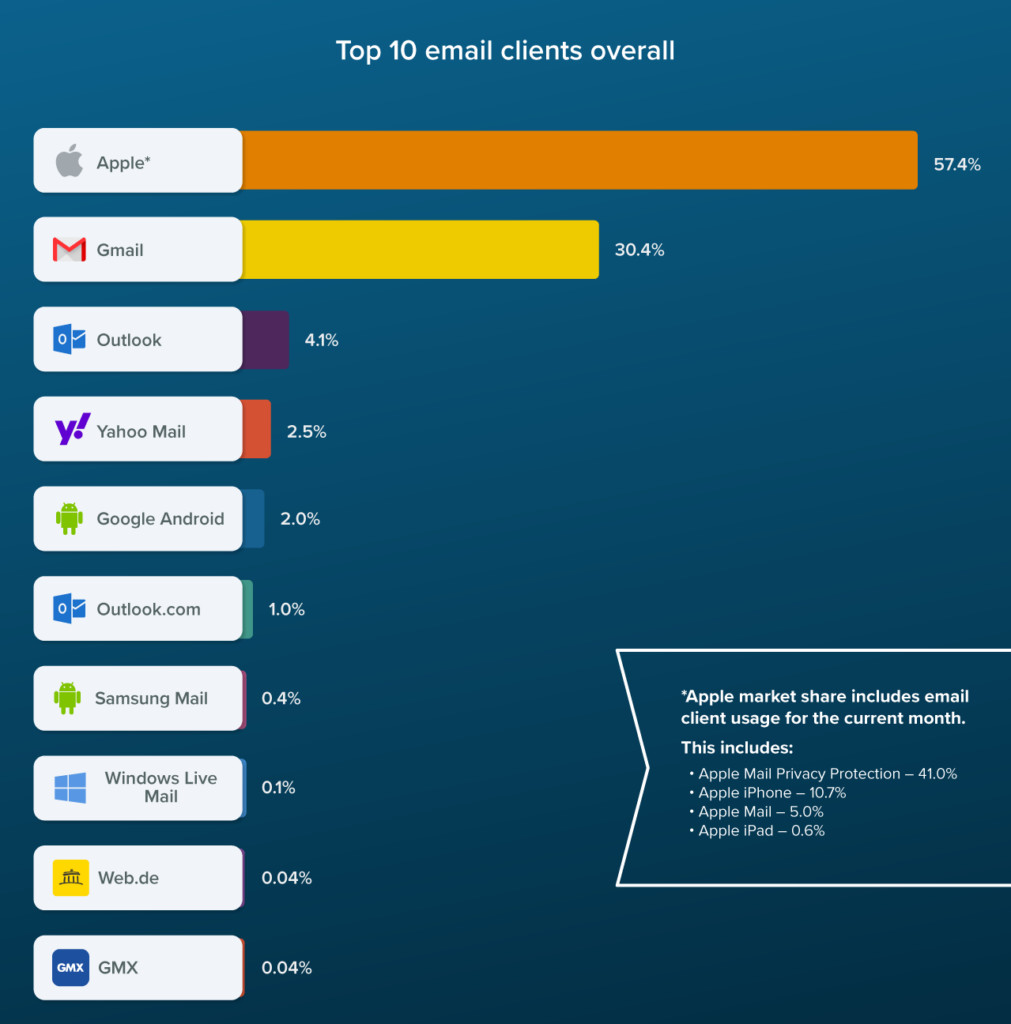
Impact of AMPP from customer analytics using key email KPIs:
We analyzed the changes at three customers with high numbers of newsletter subscribers and compared them with the previous year. The influence of AMPP on the open rate is very clearly visible for customers 1 and 2, but not at all for customer 3 at first glance. On the contrary, the trend is even lower in 2021. If we take a closer look, however, this can also be explained for the third customer.
In the following charts, we compare the open rates and CTR of the customers from 2021 with the year 2020 according to ISO calendar week.
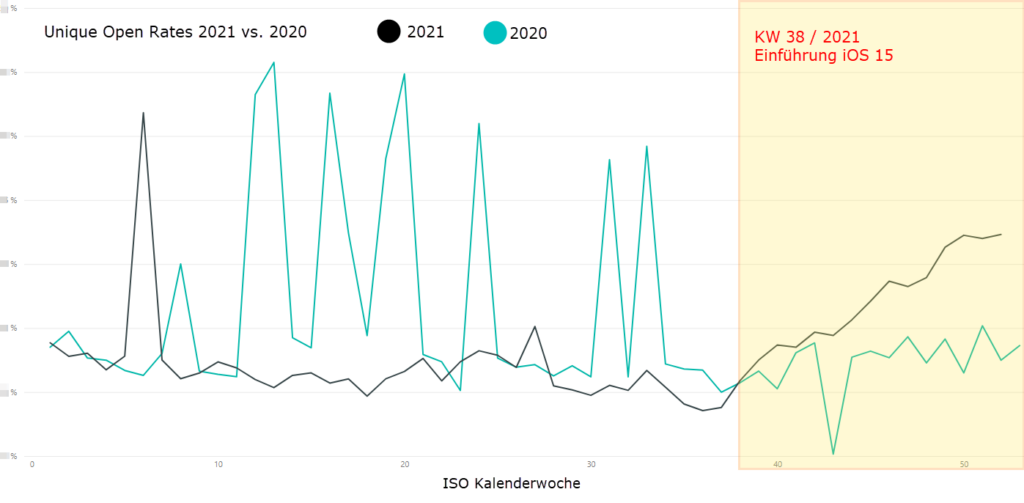
Source: Year-to-date analyses by Mayoris of Unique Open Rates and Unique Click Through Rates from Client 1 (distribution list: approx. 700,000 newsletter recipients).
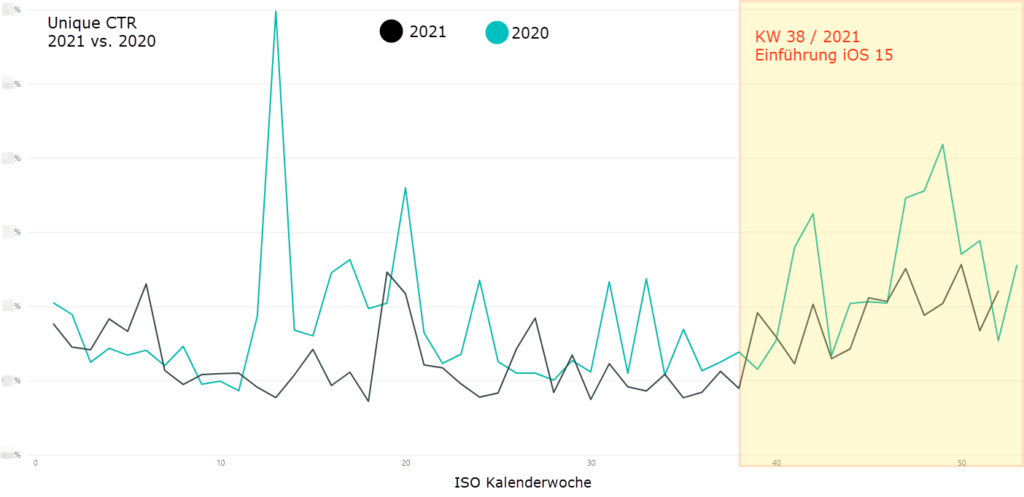
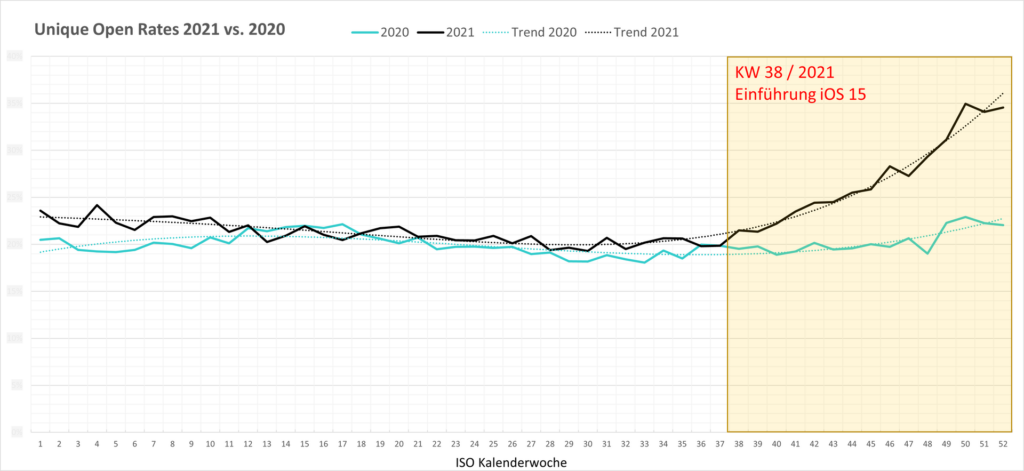
Source: Year-to-date analyses by Mayoris of Unique Open Rates and Unique Click Through Rates from Client 1 (distribution list: approx. 700,000 newsletter recipients).
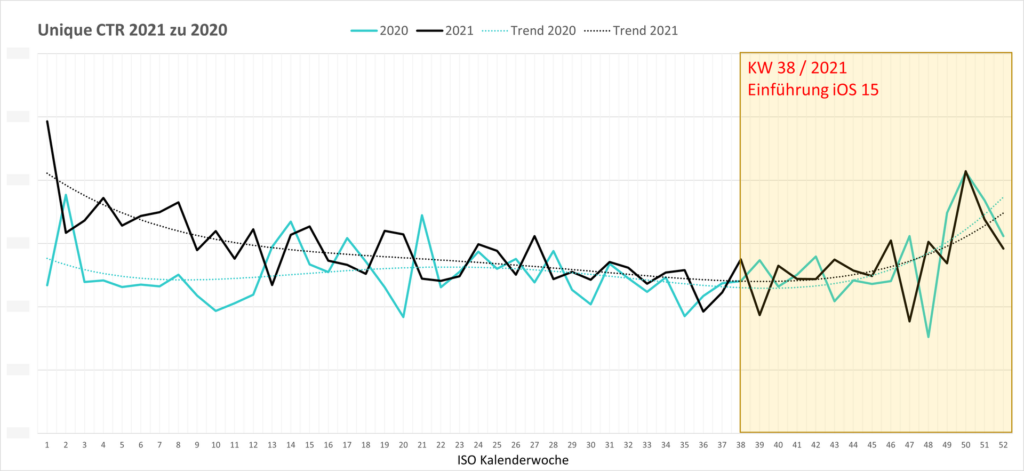
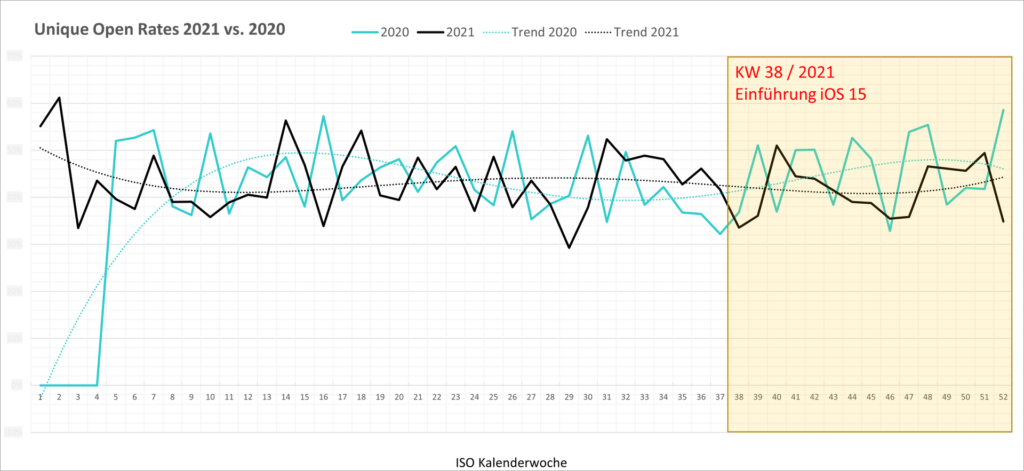
Source: Year-to-date analyses by Mayoris of Unique Open Rates and Unique Click Through Rates from client 3 (distribution list: approx. 850,000 newsletter recipients).
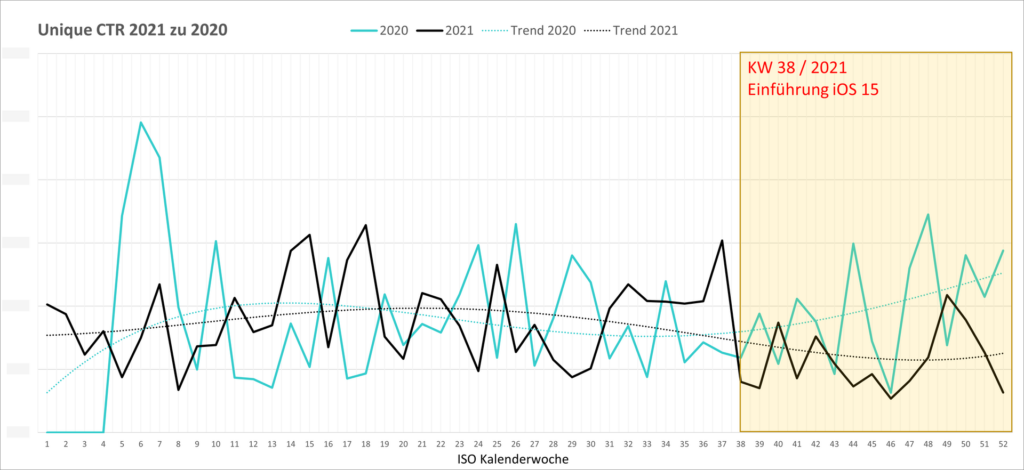
Customer 1 and 2:
From week 38 of 2021, the unique open rates (opens per user) increase sharply for the first two customers. In the previous year, however, this KPI was on the same trend and only increased slightly during the Christmas period, but significantly lower than in 2021. It could now be assumed that both companies did very well in email from fall 2021 in terms of target groups, timing, subject lines, etc. If, on the other hand, the click-through rate (CTR) is analyzed, this difference in trend is no longer apparent, or rather it tends to decline for one customer from the introduction of AMPP in fall 2021. CTR measures clicks as a percentage of emails sent, which measures the overall success of the emails of opens to clicks. This comparison between open rate and CTR shows very clearly that the 2021 open rates cannot be true. The click data, on the other hand, cannot be changed by Apple because it takes place on the customer side. Therefore, CTR remains the last important metric to measure the success of a marketing email.
Customer 3:
For this mailing list, the influence of the Apple update is not detectable, as long as only the statistics of the unique open rate are analyzed. The trend of opens is lower from the fall of 2021 than in the previous year. However, if the analysis is combined with the CTR, it can be determined that the performance of the sent newsletters in the same period of 2021 was generally lower than in the previous year. From this, it can be assumed but not confirmed that the mails had fundamental deficits in the target group definition, in the subject or even deficiencies of a content-related nature, i.e. a lack of relevance. Alternatively, this customer has a disproportionately low number of Apple users, which is why the impact on openings was not significant.
Who are affected by the changes?:
All senders are affected. As we’ve already noted above, Apple, on the one hand, has a hugely dominant position in overall email marketing. And even if the Apple user share in newsletter subscribers from certain senders should not be so dominant, the open rate should not be trusted since the fall of 2021. The influence in the B2C area is certainly greater than in the B2B area, where the Outlook share is traditionally higher, which is not affected.
But it’s best to do your own analysis for your company. Do the same year-to-date analysis on Unique OR (open rate per user) and Unique CTR (click-through rate per user) as in the graphs above. If the trend in open rate increases from fall 2021, but the trend in CTR does not, your company is most likely affected by the change.
Now what this means specifically for you as a marketing email sender:
Prior to iOS 15 in Fall 2021, you could rely on various KPIs to measure the success of your marketing emails. These metrics can also be understood as “email journey”. Each KPI gives you an indication of which adjusting screw can still be improved in an individual email or in the company’s own email marketing as a whole. You can find out more about this in the whitepaper on email key performance indicators.
Since iOS 15, the open rate and the CTO rate (Click to Open) have definitely been dropped. The opens distort the analyses enormously, even making them useless. However, Apple cannot influence the delivery rate and the CTR in email marketing. Both are also important for Apple because, on the one hand, the company wants to continue to push active bounce handling of senders and, on the other hand, is still interested in ensuring that high-quality emails with relevant content are also sent. Specifically, the changes mean the following for you:
Segmentations for individual newsletters or e-mail marketing automationMarketing Automation ist ein Framework bestehende aus Strategie (First Party Data und Marketing), Use Cases und Prozessen, Daten bzw. Customer Data Platform, Technologien, Inhalten, Organisation und Skills sowie dem Rechtsrahmen bzw. dem Consent Management....:
You can no longer use target groups taking into account non-openers of the email (e.g. reminder emails of promotions or events). Since Apple returns “phantom opens” of users to the email delivery system, you exclude recipients who did not look at the initial email.
A/B/n tests:
The most popular A/B/n tests include, for example, finding out the best subject line or the optimal time to send. The open rate used to inform these tests. Now that this KPI is gone, you have to use CTR as a metric in a new way, which increases fuzziness. It is important that you always test only one component on the email; for example, only different subject lines or different send times or days, but never two factors together. This was important before, but now that you have to take CTR as a metric, it’s even more important.
Design marketing emails in general:
Trim your newsletters and automations to optimize CTR. As before the innovation, it is also important to send an email at the right time to the right person with the right content. So design your emails so that it is only sent to recipients who are actually interested in it, the subject line with the preheader arouses curiosity and, above all, that links are clicked on in the email if possible.
The last point is the most important. The recipients should click on the content in the email and interact on your website according to your recommendations. Therefore, the email journey does not stop at the email, but continues on the website. The desired interaction on the website then depends on the use case or concept. The content in the email should make the user curious about the more comprehensive information on the website. Here, less is more: Not 10 different contents in the e-mail will interest all your newsletter subscribers, but only a few, namely the “relevant” ones. This distinction can only be made via selections or recipient attributes. More intelligent e-mail systems can show and hide content according to target groups. It is not you who decides what is important for the recipient, but the recipient himself. And that stands and falls with where the e-mail recipient is in the customer journey. Within the email, the most important KPI is and remains the CTR!
We would be happy to support you in all aspects of analytics & CRM and work with you to design your next intelligent newsletter and email marketing campaigns.
Further sources around the topic AMPP:

